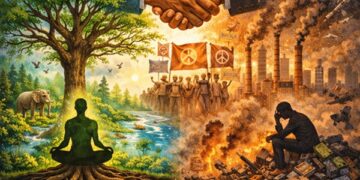By: Mehak Fayaz
For the first time since 1945, the world finds itself without a single dominant superpower—or even a stable pair of rivals. Instead, we are entering a volatile phase of fragmented multipolarity, where competing power centers and diverging visions of global order create not balance, but deep instability.
As Mark Leonard rightly notes, “Beijing and Washington do not enjoy the same global dominance that the Soviet Union and the United States did after 1945.” In 1950, the U.S. and its allies—NATO members, Australia, and Japan—alongside the communist bloc led by the USSR, China, and Eastern Europe, accounted for a staggering 88 percent of global GDP. Today, that share has fallen to just 57 percent. Not only has economic power diffused, but military power too: non-aligned countries, which contributed little to global defense spending in the 1960s, now account for 15 percent—and that number is rising.
Leonard describes this as “unbalanced multipolarity,” where the U.S. and China remain dominant, yet second-tier powers such as India, Turkey, Japan, and Germany are steadily rising. However, this shift does not translate into stability. In fact, it marks the opposite. The very structure of today’s global order—fractured, competitive, and ideologically plural—is becoming a fertile ground for unrest.
This is evident in the ongoing conflicts across the globe. The Russia–Ukraine war, which began as a pushback against NATO’s eastward expansion, has escalated into a proxy struggle involving the United States, the European Union, and their allies. Russia, in turn, uses energy blackmail, cyber-attacks, and nuclear threats as tools of confrontation. Unlike Cold War proxy wars fought in remote regions, this one is unfolding in Europe itself—dragging NATO and Russia into a direct, high-stakes standoff unseen since the Cuban Missile Crisis.
At the same time, the Israel–Palestine conflict has erupted into a regional tinderbox, increasingly pulling in Iran and the United States. The involvement of multiple great and regional powers in overlapping conflicts is not a sign of order—it is a warning.
Barry Posen provides a sobering perspective: he argues that this phase of multipolarity may persist for a long time before a new unipolar or bipolar order emerges. But such a prolonged transition carries grave risks. As material power diffuses, so does ideological cohesion. There isn’t just one challenger—there are several: China, Russia, Iran, India, Turkey. And they are operating within an ideologically fragmented landscape: liberal democracies (U.S., EU), authoritarian capitalists (China, Russia), theocracies (Iran, Saudi Arabia), hybrid democracies (India, Turkey), and military regimes (Myanmar) all seeking to reshape global rules.
Graham Allison’s theory of the “Thucydides Trap” warns that rising powers often provoke war with established hegemons—as seen in past rivalries between Athens and Sparta, Britain and Germany, or the U.S. and Japan. Meanwhile, the U.S., EU, and Japan are scrambling to preserve a crumbling liberal order. As a result, the number of possible flashpoints is no longer a few—it is many.
History, too, cautions us. Even ideological harmony has never guaranteed peace. During the Cold War, the supposed unity of the communist bloc was shattered by the Sino-Soviet split of the 1960s. In 1962, India and China—two postcolonial states with similar economic ideologies—clashed violently over territorial and strategic rivalries. The liberal democratic camp has not been immune either: the U.S.–France fallout over the 2003 Iraq War, and more recent transatlantic rifts over trade and technology, show that shared values do not override divergent national interests.
The real danger lies not just in the competition for power, but in the fight to define global norms and values. Who gets to shape the rules of international behavior? Whose vision of order will prevail? These are no longer abstract questions. They are at the core of today’s most dangerous geopolitical struggles.
History again offers troubling precedents. The multipolar systems that existed before both World Wars were marked by shifting alliances, clashing ambitions, and unresolved disputes—conditions that directly led to global conflict. These examples suggest that power transitions do not peacefully lead to new stable orders. Instead, they often pass through the fires of systemic war.
This is not just a theoretical risk. It is becoming our reality.
And here lies my deepest personal fear—not just as a student of politics, but as a concerned citizen of this world. Before the global system settles into any new configuration—whether it becomes unipolar, bipolar, or multipolar in a more structured way—it may first have to pass through a major systemic breakdown. This breakdown could take the form of a great-power war of a kind we haven’t seen since 1945. I don’t say this as a prophecy, but as a warning.
The signs are all around us: power diffusion, ideological polarization, unresolved rivalries, and technological accelerants—from AI to cyber warfare. All of these make the next global conflict not only possible, but dangerously plausible.
Whether this fate can be avoided depends on whether global leaders acknowledge these risks and act with greater urgency than the current complacent discourse allows. The storm may yet be turned aside—but only if we learn to see it coming.
The author is a Master’s student in the Department of Political Science, University of Kashmir, and can be contacted at: bhattmehak03@gmail.com





